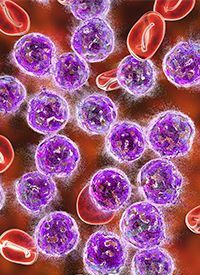Article
Pirtobrutinib Overcomes Ibrutinib, Venetoclax Resistance in Heavily Pretreated MCL Cell Lines
Author(s):
The novel non-covalent BTK inhibitor pirtobrutinib showed promising preclinical efficacy in overcoming ibrutinib and venetoclax resistance, and in limiting cell growth and inducing apoptosis in mantle cell lymphoma.

Pirtobrutinib (LOXO-305) was found to overcome both ibrutinib (Imbruvica) and venetoclax (Venclexta) resistance in heavily pretreated mantle cell lymphoma cells (MCL) cells, both in vitro and in vivo. Additionally, pirtobrutinib plus venetoclax led to improved in vivo efficacy in MCL models compared with ibrutinib combined with venetoclax, according to a poster presentation at the 2021 ASH Annual Meeting.1 Furthermore, the addition of venetoclax (Venclexta) to the novel non-covalent BTK inhibitor enhanced its efficacy in restraining tumor size.
Pirtobrutinib was also found to be more potent than ibrutinib in inhibiting cell growth and inducing higher levels of apoptosis. Additionally, an RNA-sequence analysis demonstrated significant enrichment for G2/M checkpoints and E2F targets signatures in cells treated with pirtobrutinib.
“MCL is a rare and aggressive B-cell lymphoma, characterized by poor prognosis,” said Yang Liu, PhD, of The University of Texas MD Anderson Cancer Center, in a poster presentation of the findings. “Although remarkable therapeutic advances have been made by covalent BTK inhibition, BCL-2 inhibitor minute class and CAR-T cell therapy, therapeutic resistance inevitably occurs and leads to dismal clinical outcomes. Therefore, exploration of next-generation targeted therapy is crucial to provide the clinical benefit.”
Regarding the rationale for this trial, Lui said that data from the phase 1/2 BRUIN study showed that pirtobrutinib demonstrated promising efficacy in heavily pretreated patients [with MCL], with or without a prior correlation between inhibition.
“The promising property of [pirtobrutinib] encouraged us to interrogate the underlying mechanisms in our preclinical MCL models,” Liu said.
In the preclinical study, investigators evaluated the mechanism of action of pirtobrutinib in MCL cells in vitro, and proposed the potential combination therapy in a venetoclax-resistant xenograft model. Treatment for 72 hours with dimethyl sulfoxide (DMSO), ibrutinib, and pirtobrutinib at a dosage of 10μM demonstrated that pirtobrutinib induced only marginal cell growth. Researchers used trypan blue exclusion assay to measure treatment objectives in cell lines 24, 48, and 72 hours following treatment with the agents.
For the cell line Jeko-1, cell numbers increased from 0.1 to 2.3 after treatment with DMSO compared with sustained 0.1 with ibrutinib and pirtobrutinib. In cell line Mino, cell numbers increased from 0.2 to 1.25 after 72 hours, compared with an increase to 0.35 with ibrutinib and 0.25 with pirtobrutinib.
Cell growth variety were even more pronounced in select cell lines. In Rec-1, cell growth increased from 0.2 to 1.75 with DMSO, compared with 0.75 and 0.25 with ibrutinib and pirtobrutinib, respectively. In Jeko-Ibrutinib-R, cell numbers increased from 0.2 to 2.0 with DMSO, compared with 1.5 with ibrutinib and sustained 0.2 with pirtobrutinib. In Mino-venetoclax-R, the number of cells (millions/mL) increased from 0.2 to 1.75 with DMSO vs 0.75 and 0.25, respectively. Finally, in Z-138, cell numbers increased from 0.2 to 2.0 vs 0.75 and 0.1, respectively.
Furthermore, following 20 μM of pirtobrutinib, the percentage of apoptotic cells were between 20% and 40% for lines Jeko-1, Mino, Rec-1, Jeko-Ibrutinib-R, JVM-2, and Rec-Venetoclax-R. In cell lines Mino-venetoclax-R and Z-138, the percentage of apoptotic cells were between 40% and 60%.
In comparison, treatment with ibrutinib over the same study period induced apoptosis in approximately 20% of cells for cell lines Mino and JVM-2. Treatment with ibrutinib did not induce apoptosis in greater than 20% of cells for any of the identified cell lines, and in Jeko-Ibrutinib-R, the percentage of apoptotic cells were less than 10%.
Similarly, treatment with DMSO was associated with apoptosis less than 10% across all aforementioned cell lines. In Jeko-1, Jeko-Ibrutinib-R, and Mino-Venetoclax-R, the percentage of apoptotic cells was 5% or lower.
“Pirtobrutinib both independently induced cell apoptosis and [pirtobrutinib] induced higher levels of apoptosis than that by ibrutinib in most of the tested MCL cell lines,” said Liu.
Apoptotic inductive effects were assessed using Annexin V/PI staining and propidium iodide (PI) DNA staining was conducted to evaluate the cell cycle progression kinetics between the 2 agents.
Pirtobrutinib, but not ibrutinib, resulted in G2/M cell cycle arrest, explained Liu. This assay was confirmed by looking at other BTK inhibitors, including DMSO, acalabrutinib (Calquence), zanubrutinib (Brukinsa), and nemtabrutinib (ARQ-53). Between these agents, pirtobrutinib was the only which induced cell cycle arrest in G2/M.
Notably, the blockade of cell cycle progression was positively correlated with decreased protein levels of critical regulators for S and G2/M phase transition such as cyclin-B and CDC25C, Liu said.
Lastly, Mino-venetoclax-R cells were inoculated into NSF mice to determine drug efficacy in vivo. Findings showed thattumor volume (mm3) after 24 days was lowest with a combination of pirtobrutinib and venetoclax at around 100 mm3, compared with 200, 600, 700, 1200 and 2000 with ibrutinib and venetoclax, ibrutinib at 50 mg/kg, venetoclax at 10 mg/kg, pirtobrutinib at 50 mg/kg and the vehicle, respectively.
In regard to tumor weight (g), treatment with the aforementioned combination resulted in a weight of 0.2 g, compared with ranges spanning between 0.25 and 1.25 with pirtobrutinib, 0.2 and 0.5 with ibrutinib plus venetoclax, 0.4 and 0.7 with ibrutinib, 0.25 and 0.7 withvenetoclax, and 0.57 and 1.25 with the vehicle.
The combination of pirtobrutinib and venetoclax, in addition to being the most effective in inhibiting tumor growth, was also well tolerated in the mice, according to the researchers, and did not affect overall body weight in the mice.
Reference
- Jiang C, Yan F, McIntosh J, et al. Pirtobrutinib overcomes ibrutinib and venetoclax resistance in mantle cell lymphoma. Presented at: 2021 ASH Annual Meeting and Exposition; December 11-14, 2021; Atlanta, GA. Abstract 1182.









